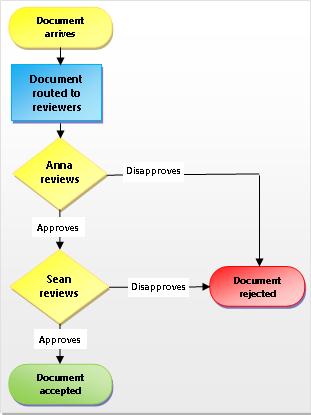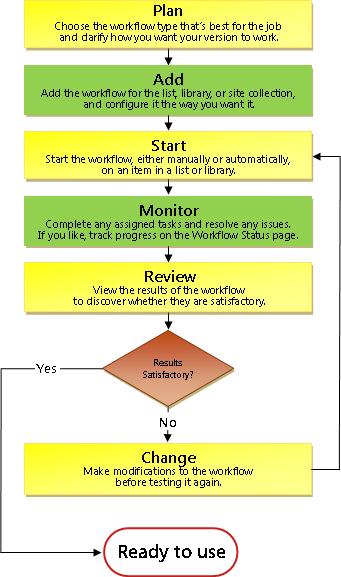Overview of workflows included with SharePoint
SharePoint workflows are pre-programmed mini-applications that streamline and automate a wide variety of business processes. Workflows can range from collecting signatures, feedback, or approvals for a plan or document, to tracking the current status of a routine procedure. SharePoint workflows are designed to save you time and effort, and to bring consistency and efficiency to tasks that you perform on a regular basis.
What is a SharePoint workflow?
You probably already know what a flowchart is. It's a graphical map of a process, with instructions about what happens at each step.

A SharePoint workflow is like an automated flowchart that takes a lot of the labor, guesswork, and randomness out of your standard work processes.
For example, look at the document approval-process in the illustration. Running this process manually can mean a lot of checking up and keeping track, forwarding documents and sending reminders — and each of those tasks has to be performed by you or by one or more of your colleagues. That means a lot of extra work and (maybe even worse) a constant stream of interruptions.
But when you use the SharePoint Document Approval workflow to run the process, all of that checking and tracking and reminding and forwarding is done by the workflow, automatically. If someone is late in completing a task, or if some other hitch arises, most of the included workflows generate a notification to let you know about it. Nobody in the group has to proactively monitor the process because with a SharePoint workflow, the process is always proactively monitoring itself.
And running a SharePoint workflow is easy. You just choose the workflow type you want, specify the options that will work best in your situation, then let the workflow take over. And of course, you can cancel or terminate a workflow whenever you need to.
What processes can I automate by using a SharePoint workflow?
Each of the workflow types included act like a template. You add a version of the workflow for a single list or library, or for a whole site collection using an initiation form to specify the options and selections that you want for this version. These options and selections include who the workflow assigns tasks to, task deadlines, how the workflow can be started and by whom, instructions to be included in the task notifications, and so forth.
Important: By default, the Approval, Collect Feedback ,and Collect Signature workflows are not activated and are not listed in the Select a workflow template list box of the association form. To make them available for use, a site administrator must activate them at the site collection level.
There are five pre-programmed workflow types.
Approval (route a document or item for approval or rejection)
 An Approval workflow routes a document or other item to designated people for their approval or rejection. You can also use an Approval workflow to control content approval in a list or library. To learn more, and for step-by-step instructions, see All about Approval workflows.
An Approval workflow routes a document or other item to designated people for their approval or rejection. You can also use an Approval workflow to control content approval in a list or library. To learn more, and for step-by-step instructions, see All about Approval workflows.
Collect Feedback (route a document or item for feedback)
 A Collect Feedback workflow routes a document or other item to designated people for their feedback. The Collect Feedback workflow consolidates all of the feedback from participants for the workflow owner and provides a record of the review process. To learn more, and for step-by-step instructions, see All about Collect Feedback workflows.
A Collect Feedback workflow routes a document or other item to designated people for their feedback. The Collect Feedback workflow consolidates all of the feedback from participants for the workflow owner and provides a record of the review process. To learn more, and for step-by-step instructions, see All about Collect Feedback workflows.
Collect Signatures (route a document, workbook, or form for digital signatures)
 The Collect Signatures workflow routes a Microsoft Office document to designated people for their digital signatures. Note that the Collect Signatures workflow functions only with Word documents, Excel workbooks, and InfoPath forms. To learn more, and for step-by-step instructions, see All about Collect Signatures workflows.
The Collect Signatures workflow routes a Microsoft Office document to designated people for their digital signatures. Note that the Collect Signatures workflow functions only with Word documents, Excel workbooks, and InfoPath forms. To learn more, and for step-by-step instructions, see All about Collect Signatures workflows.
Three-State (track an issue, project, or task through three states or phases)
 The Three-state workflow is designed to track the status of a list item through three states (phases). It can be used to manage business processes that require organizations to track a high volume of issues or items — customer support issues, sales leads, or project tasks, for example.
The Three-state workflow is designed to track the status of a list item through three states (phases). It can be used to manage business processes that require organizations to track a high volume of issues or items — customer support issues, sales leads, or project tasks, for example.
With each transition between states, the workflow assigns a task to a person and sends that person an e-mail alert about the task. When this task is completed, the workflow updates the status of the item and progresses to the next state. The Three-state workflow is designed to work with the Issue Tracking list template, but it can be used with any list that contains a Choice column that has three or more values.
To learn more, and for step-by-step instructions, see Use a Three-state workflow.
Publishing Approval (automate content routing for review and approval)
 A publishing approval workflow is similar to other SharePoint workflows in that it automates the routing of content to subject matter experts and stakeholders for review and approval. What makes the publishing approval workflow unique is that it's designed specifically for publishing sites where the publishing of new and updated web pages is tightly controlled. In these kinds of sites, no new content can be published until it has been approved by every approver in the workflow. To learn more, and for step-by-step instructions, see Work with a publishing approval workflow.
A publishing approval workflow is similar to other SharePoint workflows in that it automates the routing of content to subject matter experts and stakeholders for review and approval. What makes the publishing approval workflow unique is that it's designed specifically for publishing sites where the publishing of new and updated web pages is tightly controlled. In these kinds of sites, no new content can be published until it has been approved by every approver in the workflow. To learn more, and for step-by-step instructions, see Work with a publishing approval workflow.
Who can add and start a SharePoint workflow?
To add or start a workflow, you must have the correct permission for the list, library, or site collection where the workflow runs:
-
To add a workflow By default, you must have the Manage Lists permission to add a workflow. (The Owners group has the Manage Lists permission by default; the Members group and the Visitors group do not.)
-
To start a workflow Also by default, you must have the Edit Items permission to start a workflow that's already been added. (The Members group and the Owners group both have the Edit Items permission by default; the Visitors group does not.)
Alternatively, Owners can choose to configure specific workflows so that they can be started only by members of the Owners group.
How do I add and run a SharePoint workflow?
The following diagram provides a high-level view of the basic stages for planning, adding, running, and modifying a SharePoint workflow. Individual sections on each of the steps follow.

-
Plan Make sure that you know which options you want and what information you'll need to have available when you use the initiation form to add your version of the workflow.
-
Add Fill out the initiation form to add your workflow version to a list, library, or site collection.
-
Start Start your new workflow, either manually or automatically, on a document or other item in a list or library. (If you start it manually, you'll have the opportunity to change some of the workflow's association form settings on a briefer initiation form.) When the workflow starts, it creates tasks, sends notification messages, and begins to track actions and events.
-
Monitor While the workflow is running, you can view the Workflow Status page to see which tasks are complete and what other actions have occurred. If necessary, you can adjust current and future tasks from here, and even cancel or terminate this workflow run.
-
Review When the run is complete, its whole history can be reviewed on the Workflow Status page. Also from the status page, statistical reports on the general performance of this workflow can be created.
-
Change If the workflow isn't working quite like you want it to, you can open the original association form that you used to add it, and make your changes there.
Can I create custom SharePoint workflows of my own?
If you need more flexibility with a built-in workflow, you can customize it further with a tool like SharePoint Designer 2013. You can also create your own original workflow from scratch.
Using the Workflow Designer, you create rules that associate conditions and actions with items in SharePoint lists and libraries. Changes to items in lists or libraries trigger actions in the workflow.
For example, you could design a workflow that launches an additional approval workflow, if the cost of an item exceeds a specific amount.
You can also define a workflow for a set of related documents. For example, if your workflow is associated to a document library, or if it is filtered to the Document content type, a group of contextual Document Set actions appear. A Document Set allows a group of documents to be treated as a single unit, so a workflow action for a Document Set will run on each of the items in that Document Set.
Amazing post! Such workflow automation applications can certainly help enterprises improve their operational efficiencies.
ReplyDeleteI have read your blog and I gathered some needful information from your blog. Keep update your blog. Awaiting for your next update.
ReplyDeleteBlockchain Technology